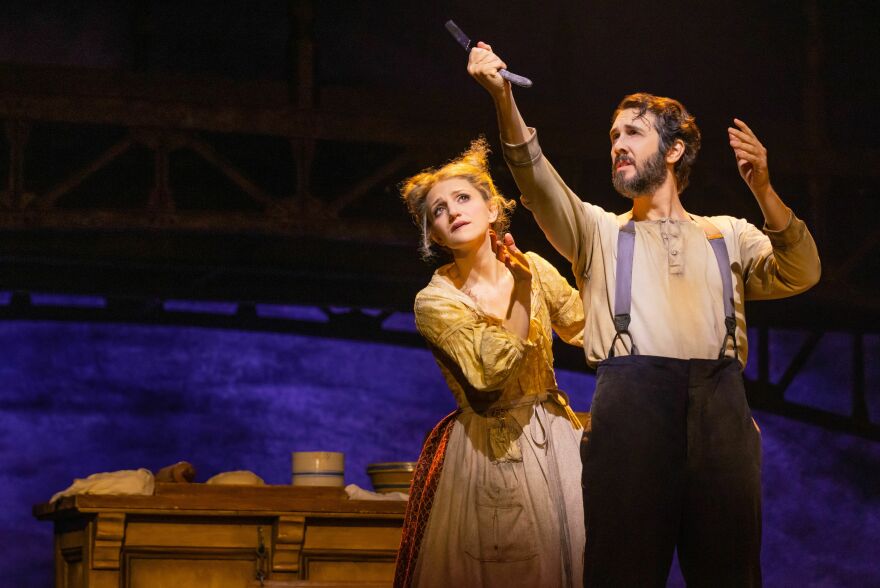Even as a controversy has erupted on Broadway over the use of pre-recorded music in the upcoming David Byrne musical, Here Lies Love, audiences for some musicals this past season are noticing the return of something that was once familiar: big orchestras.
When Sweeney Todd premiered in 1979, composer Jonathan Tunick orchestrated it for 26 musicians. But in every subsequent Broadway appearance, it's used a smaller orchestra ... until now. The new revival, starring Josh Groban and Annaleigh Ashford, features the full complement of strings, woodwinds, brass, harp and percussion.
"It feels normal," to work with an ensemble that large, said Tunick, laughing. Back in the 1970s, he orchestrated Sondheim's massive score in three-and-a-half weeks and has done 13 different versions of it since, written for everything from chamber ensembles to a full-size symphonic accompaniment on Tim Burton's film.
Tunick said audiences can feel the weight of the 26 pieces in the opening number. The orchestra is quiet, at the beginning, but then "the brass come in for the first time supporting the chorus, except for the low instruments. We hold them off to the second bar." He demonstrated, singing: "Swing your razor wide – BOOM – Sweeney!"
"This is just such a rarity, to have this many pieces underneath you," said Annaleigh Ashford, who plays Mrs. Lovett. "It's quite overwhelming and spectacular."

Ashford has been in a lot of musicals but Sweeney Todd is the first time she's working with a pit orchestra this large. "I think that anybody who has been in the American musical theater in the last 20 years has not had the opportunity to sing with an orchestra this large," she said. "It's just frankly not feasible from a financial standpoint."
Finances aren't the only reason orchestras are small
In fact, many producers have reduced the sizes of orchestras playing classic shows, citing finances. Broadway was shut down by a musician's strike 20 years ago over just this issue.
Yet finances are not the only reason to keep an orchestra small. "I think the style of music is changing," said Alex Lacamoire, who's Sweeney Todd's music director. He orchestrated and conducted 10 musicians in Hamilton. "Hamilton did not need 26 musicians."
Jeffrey Seller, who is a producer on both Hamilton and Sweeney Todd said that Sweeney is a different case, exactly because it has been revived so many times on so many different stages. "It just felt to us as if one very big reason for doing this production was to give the audience the full experience of the sound, of the orchestration of the music as Sondheim and his orchestrator Tunick imagined it," he said.
A big orchestra allows the audience to have a "goosebump experience," he said. The orchestra size has been part of the revival's marketing strategy.
"I thought we could do it responsibly so that we could make a modest profit for our investors," says Seller. "A killing? No way. A modest profit? Sure. Is that worth 26 musicians? You bet."
Golden age orchestras meant balanced acoustic sound
In Broadway's golden age, large orchestras were routine. Orchestra members and actors rarely used microphones, so orchestrators had to think about how to balance the sound so that singers weren't overwhelmed.

Kimberly Grigsby, who conducts the 30-piece orchestra for the current revival of Camelot, said the show's two original orchestrators, Robert Russell Bennett and Philip J. Lang, "get out of the way of the voice. If we play what's on the page and play the dynamics that are given, no one has to be in the back of the house, [using the sound board and] pulling down the orchestra or pushing the orchestra."
In fact, in an age when most musicians listen in the pit with in-ear monitors, she's suggested the ensemble just listen to each other acoustically. "I encourage you listen to the room," she told the orchestra, "listen to the singer, listen to one another. Let's make music together."
Phillipa Soo, who plays Guinevere in the show, said she feels supported by the big orchestra, not just musically, but dramatically. "I feel so lucky that we get to have them there with us, basically being, like, the ground under our feet. And it's such a beautiful relationship that we get to have with musicians in our storytelling."

Camelot is at Lincoln Center Theater, which is a non-profit. It has the resources to present old shows with big ensembles – they have produced My Fair Lady, The King and I and South Pacific full-out. But new shows are risky and expensive, so musical ensembles are usually kept small. Some musicals, like Six, only have a band of four.
A world of magic
Some Like It Hot, with a jazz score set during the prohibition, is at the higher end of the spectrum, with 17 musicians, said Charlie Rosen, who co-orchestrated the show with Bryan Carter.

"Outside of revivals, it's incredibly rare for a new musical to have a pit this big," Rosen said. "And that's sad, because to get this sound of this era – of musical theater and MGM movies – this is like the minimum you can get away with. And we're on the small side for that. We only have three strings and they're cranking in there!"
Ashford, starring in Sweeney Todd, said she had a suggestion for people who see musicals on Broadway, especially those coming to a show with one of these rare, large, "luxurious" orchestras: "Just take a moment and look down in the pit before you leave the house, because it's just a world of magic down there," she said.
And then, she said, they should stick around after the curtain call to hear the orchestra play the exit music – and give the musicians a hand.
Copyright 2023 NPR. To see more, visit https://www.npr.org.



